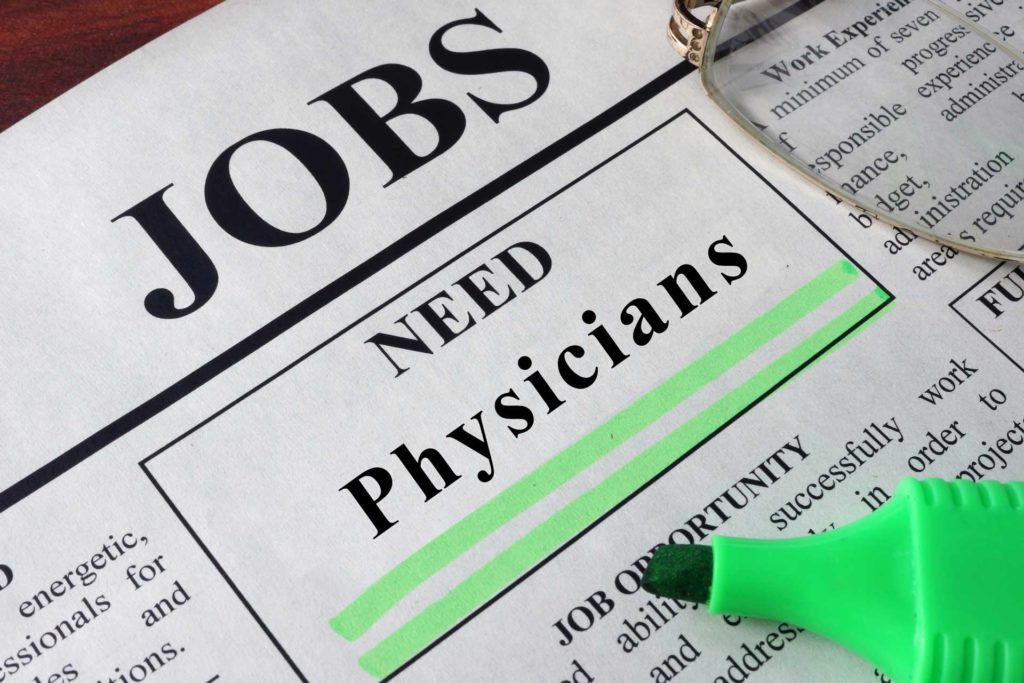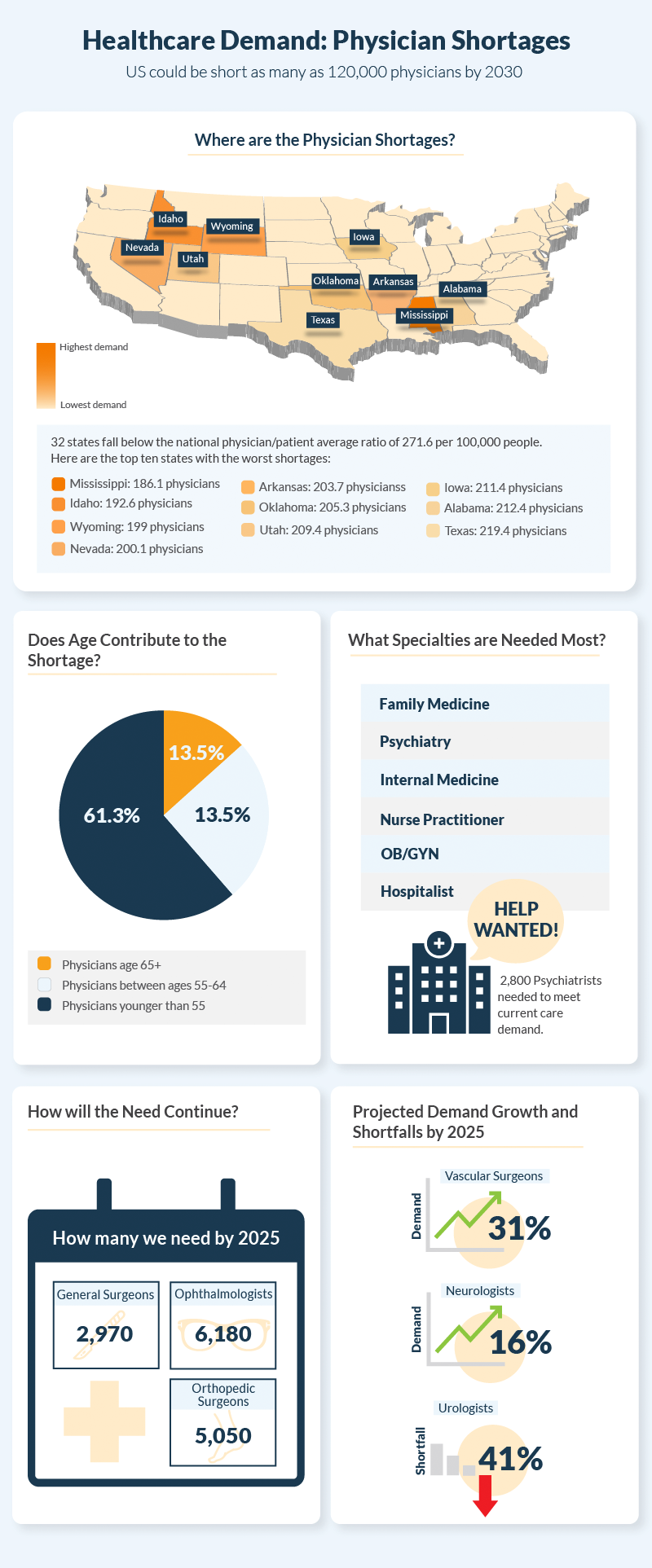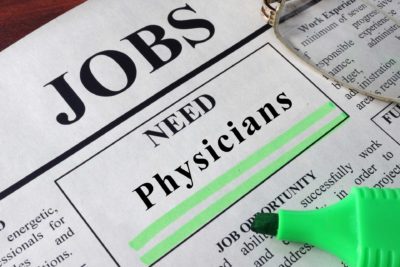It’s well known that there is a physician shortage looming in America. It’s estimated that the US could be short as many as 120,000 physicians by 2030. The latest report shows that nearly 13,800 primary care physicians and 33,800 and 72,700 physicians in non-primary care specialties will be needed. That includes a shortage of between 20,700 and 30,500 physicians for surgical specialties. Shortage estimates are growing at an alarming rate. Last year’s projected estimate was that the country was short between 40,800 and 104,900 physicians. These shortages may provide new opportunities for physicians looking for challenging positions.
Where are the Physician Shortages?
There is no guarantee that physician shortages exist in the states where a physician actually wants to live. In fact, that is one of the key elements creating the unequal distribution of physicians across the country. Physician shortages exist in different areas because some states lack good housing, expensive housing, unappealing geography, lack of professional challenges and other factors.
Across the US, the average physician to patient ratio is 271.6 per 100,000 people. Actual numbers range from a high of 443.5 physicians per 100,000 people in Massachusetts to a low of 186.1 physicians in Mississippi. It’s no surprise that Northeast states have the highest number of physicians, given that it has the highest concentration of academic teaching and research hospitals.
There a total of 32 states that fall below the national physician/patient average ratio. Here are the top ten states with the worst physician shortages. The physician ratios per 100,000 people in those states are as follows:
- Mississippi: 186.1 physicians
- Idaho: 192.6 physicians
- Wyoming: 199 physicians
- Nevada: 200.1 physicians
- Arkansas: 203.7 physicians
- Oklahoma: 205.3 physicians
- Utah: 209.4 physicians
- Iowa: 211.4 physicians
- Alabama: 212.4 physicians
- Texas: 219.4 physicians
The good news is that some of these states offer the highest physician salaries in the country. When Medscape published its latest physician compensation report, it listed salaries from high to low by geographic region:
- North Central including Iowa, Idaho, Oklahoma: $319,000
- Southeast including Mississippi, Alabama: $309,000
- Northwest including Wyoming: $306,000
- South Central including Texas, Arkansas: $303,000
- Great Lakes: $303,000
- West: $299,000
- Mid-Atlantic: $282,000
- Southwest including Nevada, Utah: $277,000
- Northeast: $275,000
Aging and a Shrinking Workforce
The aging of the US population is impacting healthcare and the physician workforce. The sheer size of the baby boomer generation has impacted every societal system they have touched. Medicine is no different. As baby boomers age two things are happening within healthcare:
1: Baby boomers consume more health care services than any other demographic
2: Baby boomer physicians are retiring out of the system just as more of them need care
When considering the projected physician shortage through 2030, those are the decades when the US demographic under the age of 18 is projected to grow by a small 3%. However, during that same time, the 65+ demographic is expected to grow by 50%. Within that demographic is retiring physicians. In the next ten years, more than 1/3 of all physicians currently practicing will reach the age of 65.
Many have already reached the age of 65 and are still practicing medicine:
- Physicians aged 65 and older comprise 13.5% of the active workforce
- Physicians between the ages of 55 and 64 comprise 25.2% of the active workforce
What are the Shortages
That brings us to the question of exactly what type of specialties are going to be needed in the coming decades. Certainly, primary care physicians are at the top of every list and there are a lot of lists. One of the most recent reports based on search assignments shows the following top twenty specialties are in the highest demand (and the average salary):
- Family medicine — $231,000
- Psychiatry — $263,000
- Internal medicine — $257,000
- Nurse practitioner — $123,000
- Obstetrician/gynecologist — $335,000
- Hospitalist — $264,000
- Emergency medicine — $349,000
- Physician assistant — $120,000
- Dermatology — $421,000
- Radiology — $436,000
- Pediatrics — $240,000
- Urgent care — $219,000
- Gastroenterology — $492,000
- Pulmonology — $390,000
- Cardiology — $428,000 for non-invasive and $563,000 for invasive
- Orthopedic surgery — $579,000
- Neurology — $305,000
- General surgery — $411,000
- Anesthesiology — $376,000
- Otolaryngology — $468,000
The latest article on physician shortages from the New England Journal of Medicine gives a lot of valuable data on the current status of this problem in the US. Here is the NEJM “by the numbers” look at the specialties needed by the year 2025:
- 2,800 more psychiatrists are needed just to meet current care demands.
- Currently, there is a 41% shortfall in urology.
- Needed: 2,970 general surgeons, 6,180 ophthalmologists, and 5,050 orthopedic surgeons
- Demand growth for vascular surgeons is 31%
- The supply of neurologists will grow by 11% between now and 2025, while demand is projected to grow by 16%.
- 40% of the population is expected to have cardiovascular disease by 2030.
- There were 2,598 general cardiology fellows in 2014, a 20% increase from 2005.
- Applications to interventional cardiology training programs increased by over 30% from 2011 to 2015.
The top-five shortage-fueled recruiting challenges:
- Psychiatry
- Emergency medicine
- Hospitalist medicine
- Endocrinology
- Rheumatology
It’s clear that physicians can write their own ticket when it comes to employment in the coming years. The question is where to go and what populations to serve. Self-employed physicians earn 28% more than employed physicians ($343,000 compared to $269,000) so that may lead to more solo practices and innovative care models. There are areas of the country in dire need of physicians. We hope that graduating classes in the coming decade will consider serving them.







